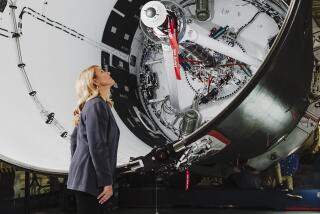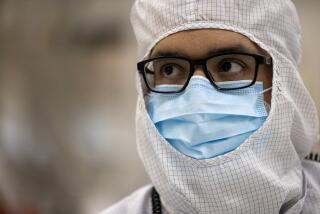F. David Riel Director, systems engineering and...
F. David Riel Director, systems engineering and integration, McDonnell Douglas’ Space Station Division
F. David Riel is one of many engineering managers working for McDonnell Douglas’ Space Station Division in Huntington Beach. He is largely removed from the political debate in Washington about the fate of the multibillion-dollar Space Station Freedom project. A picture on his wall depicts the Russian Mir space station and asks, “Shouldn’t we be there too?” He supervises about 105 engineers responsible for making sure the station will work. Riel, 57, shared his personal thoughts recently with Times staff writer Dean Takahashi.
What is your background in working on the space station?
I first began to work on the space station program in 1963. We did a study for a manned orbital space laboratory at Douglas. I was young and excited and everything was new. It focused on things that weren’t in the textbook. I’ve been involved in the program on and off ever since, as well as others.
This current cycle started in 1984 with a study to develop mission requirements about what it should do, where it should fly.
It’s all been exciting and rewarding work. Now we’re getting to the point of the culmination of all that activity. Now I am seeing holes being drilled, metal being worked, and so we’re starting to see construction.
Why have you worked so long on this project?
It’s exciting to see the young folks interested and plow forward. We don’t work here first for family or company or the agency. People work for their own self-satisfaction. They have a certain belief that this is the right thing to do. That’s why you see people working so hard despite the political turmoil. I’m amazed at how people continue despite the job and political insecurity.
How did you become interested in it?
I was always interested in how things work, the mechanics of things. My father was a cabinetmaker and that led me to engineering. In high school, I used to build model rockets. I liked physics and the sciences and wasn’t especially terrific at it. I never had a dream to be a space engineer. I don’t enjoy science fiction at all. I like the real stuff, and that led me here. I have no intention of retiring. I enjoy it so much. The work is very demanding and difficult, and you have to carry a lot of things around in your head at once.
Is there a kind of culture specific to the engineers who work on the station, like your own kind of lingo?
Not really, though we use acronyms for everything here instead of the long, descriptive words that most people wouldn’t understand. After a time here, it becomes part of everyone’s repertoire. You lose your personal identity somewhat and become part of what we call a “mission build team.”
What do you do?
I’m director of systems engineering and integration. We’re the branch that is responsible for developing the mission requirements for the station, the specifications, the kinds of robotic activity that will take place and how things work together. I think we have a reasonably glamorous job.
We deal with all types of people involved in the project, either at the Johnson Space Center in Houston or at NASA in Washington. I go there (Washington) on a weekly basis. I’ve had some contact with congressional staff and members to show them what we’re doing. A lot of people are not aware of how far along we are. People are surprised to see that we have bulkheads that will actually be part of the station.
Are you concerned about losing the funding this time?
I’ve been through the process of going to the trough to get a drink since 1963. It’s natural as a part of our political process. But it’s the first time we’ve built equipment and gotten this far. I’m not cynical because I realize that when you build a decade-long project and you have yearly budget cycles and four-year presidential cycles, continuity is something that is always in jeopardy. What proposal is McDonnell Douglas backing for the redesign of the space station?
Well, the redesign team has sent its three proposals to the White House. Daniel Goldin (NASA administrator) did state that NASA did not select a final concept and will leave that to the White House. It’s clear to us the best way to preserve the investment of the last nine years is known as option B, a ($13.3-billion) derivative that curtails some of the capabilities of the station but preserves its concept in a way that keeps it within budget. We think it would be a serious mistake not to have a station. The debates have taken place over time and the station that has survived is still the basic configuration.
What features do you think the station should have, regardless of which design is chosen?
It should serve the needs of a variety of tasks; have the ability to accept payloads from the shuttle, an internal pressurized environment for experiments, resources for power and computing, communications abilities--all things that could be used together. It should be flexible to enable us to use the right features when you need it, and it should be modular so that you can assemble it, maintain it and expand it in the future.
When you talk about the space station and why it should be built, what argument do you use?
It represents an enabling capability, like building a laboratory or a wind tunnel. It gives you the capability to do things. You don’t know what they will be ahead of time. We trap ourselves with arguments about economic return, such as it will help us make better ball bearings. You can always find a few items that can justify it. But the whole aerophysics and airplane industry benefited from the existence of wind tunnels, where you conduct experiments on aerodynamics. I see the same thing for the space station. If Queen Isabella asked Columbus to give a return on investment for his trip, it never would have happened.
More to Read
Sign up for Essential California
The most important California stories and recommendations in your inbox every morning.
You may occasionally receive promotional content from the Los Angeles Times.










